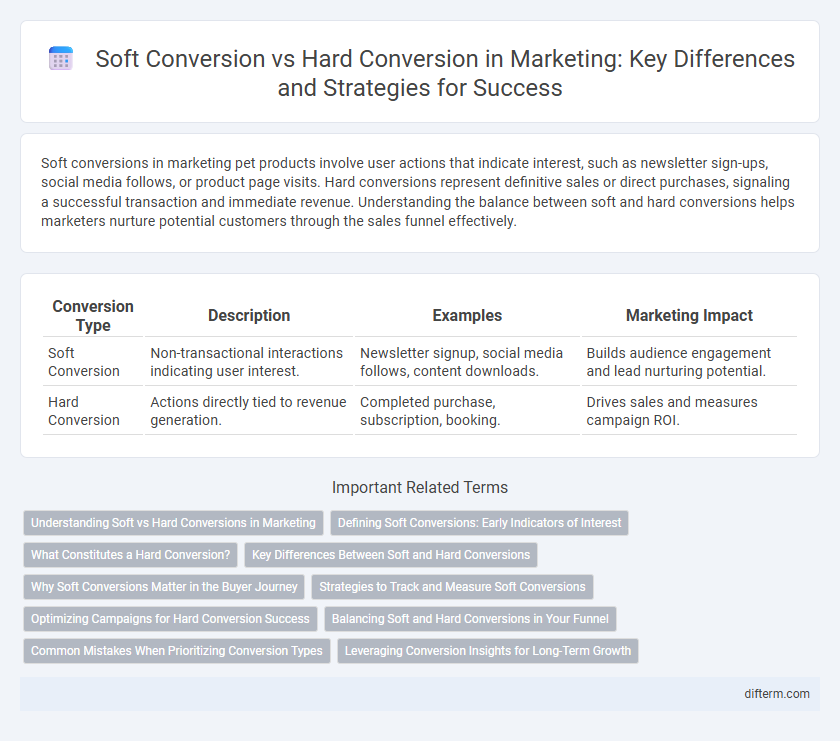Soft conversions in marketing pet products involve user actions that indicate interest, such as newsletter sign-ups, social media follows, or product page visits. Hard conversions represent definitive sales or direct purchases, signaling a successful transaction and immediate revenue. Understanding the balance between soft and hard conversions helps marketers nurture potential customers through the sales funnel effectively.
Table of Comparison
| Conversion Type | Description | Examples | Marketing Impact |
|---|---|---|---|
| Soft Conversion | Non-transactional interactions indicating user interest. | Newsletter signup, social media follows, content downloads. | Builds audience engagement and lead nurturing potential. |
| Hard Conversion | Actions directly tied to revenue generation. | Completed purchase, subscription, booking. | Drives sales and measures campaign ROI. |
Understanding Soft vs Hard Conversions in Marketing
Soft conversions in marketing refer to preliminary actions like newsletter sign-ups or social media engagement that indicate interest but do not directly generate revenue. Hard conversions are definitive actions such as purchases or subscription payments that directly impact business goals. Understanding the difference helps marketers optimize campaigns by nurturing leads through soft conversions until they achieve valuable hard conversions.
Defining Soft Conversions: Early Indicators of Interest
Soft conversions serve as early indicators of user interest by tracking micro-engagements such as newsletter sign-ups, content downloads, or time spent on site, which signal potential future actions. These interactions help marketers refine targeting strategies and nurture leads through personalized content before pushing for hard conversions like purchases or subscriptions. Monitoring soft conversions allows for a deeper understanding of customer journeys and more effective optimization of marketing funnels.
What Constitutes a Hard Conversion?
A hard conversion in marketing refers to a specific action that directly generates revenue, such as completing a purchase, signing a contract, or subscribing to a paid service. These conversions indicate a clear return on investment (ROI) and are often used to measure campaign effectiveness and sales performance. Tracking hard conversions enables marketers to optimize strategies by focusing on actions that drive immediate business growth.
Key Differences Between Soft and Hard Conversions
Soft conversions refer to preliminary user actions such as newsletter sign-ups, content downloads, or social media engagement that indicate interest but do not result in immediate revenue. Hard conversions involve direct actions that generate measurable sales or revenue, such as product purchases, subscription sign-ups, or service enrollments. Understanding these distinctions helps marketers tailor strategies by nurturing leads through soft conversions before driving them toward hard conversions for maximum ROI.
Why Soft Conversions Matter in the Buyer Journey
Soft conversions matter in the buyer journey because they indicate strong engagement signals such as newsletter sign-ups, content downloads, or social media interactions that nurture leads and build trust. These actions provide valuable data for marketers to tailor personalized follow-ups and nurture campaigns, increasing the likelihood of eventual hard conversions like purchases or subscriptions. Tracking soft conversions helps optimize marketing strategies by revealing customer interests and behaviors early in the buying process.
Strategies to Track and Measure Soft Conversions
Soft conversions, such as newsletter sign-ups or content downloads, require tracking tools like event tracking in Google Analytics or custom parameters in Facebook Pixel to accurately measure user engagement before a purchase. Implementing multi-channel attribution models helps marketers understand the influence of soft conversions across different touchpoints in the customer journey. Optimizing CRM integration and marketing automation platforms enhances data collection on soft conversions, enabling more effective lead nurturing and campaign adjustment strategies.
Optimizing Campaigns for Hard Conversion Success
Optimizing campaigns for hard conversion success requires a strategic focus on clear, measurable actions such as purchases, sign-ups, or form completions that directly impact revenue generation. Leveraging precise targeting, compelling calls-to-action, and continuous A/B testing enhances the likelihood of driving these definitive outcomes. Accurate tracking and analytics enable marketers to refine budget allocation and campaign elements to maximize return on investment and achieve tangible business goals.
Balancing Soft and Hard Conversions in Your Funnel
Balancing soft and hard conversions in your marketing funnel enhances customer engagement and drives sales effectively. Soft conversions, such as newsletter sign-ups or content downloads, build trust and nurture leads, while hard conversions directly impact revenue through purchases or subscription sign-ups. Optimizing touchpoints to encourage soft actions initially, then guiding prospects toward hard conversions, increases overall funnel efficiency and long-term ROI.
Common Mistakes When Prioritizing Conversion Types
Marketers often err by overemphasizing hard conversions like purchases while neglecting soft conversions such as newsletter sign-ups or content downloads, which are crucial for nurturing leads and long-term engagement. Ignoring the value of soft conversions can result in misallocating budget and missing opportunities to build customer relationships. Effective marketing strategies balance both conversion types to optimize the sales funnel and improve overall campaign performance.
Leveraging Conversion Insights for Long-Term Growth
Soft conversions, such as newsletter sign-ups or content downloads, provide valuable customer engagement data that informs targeted marketing strategies. Tracking these engagements helps identify high-intent leads before they complete hard conversions like purchases or subscriptions. Leveraging insights from soft conversions enables businesses to refine customer journeys and optimize campaigns for sustained long-term growth.
Soft conversion vs hard conversion Infographic

 difterm.com
difterm.com